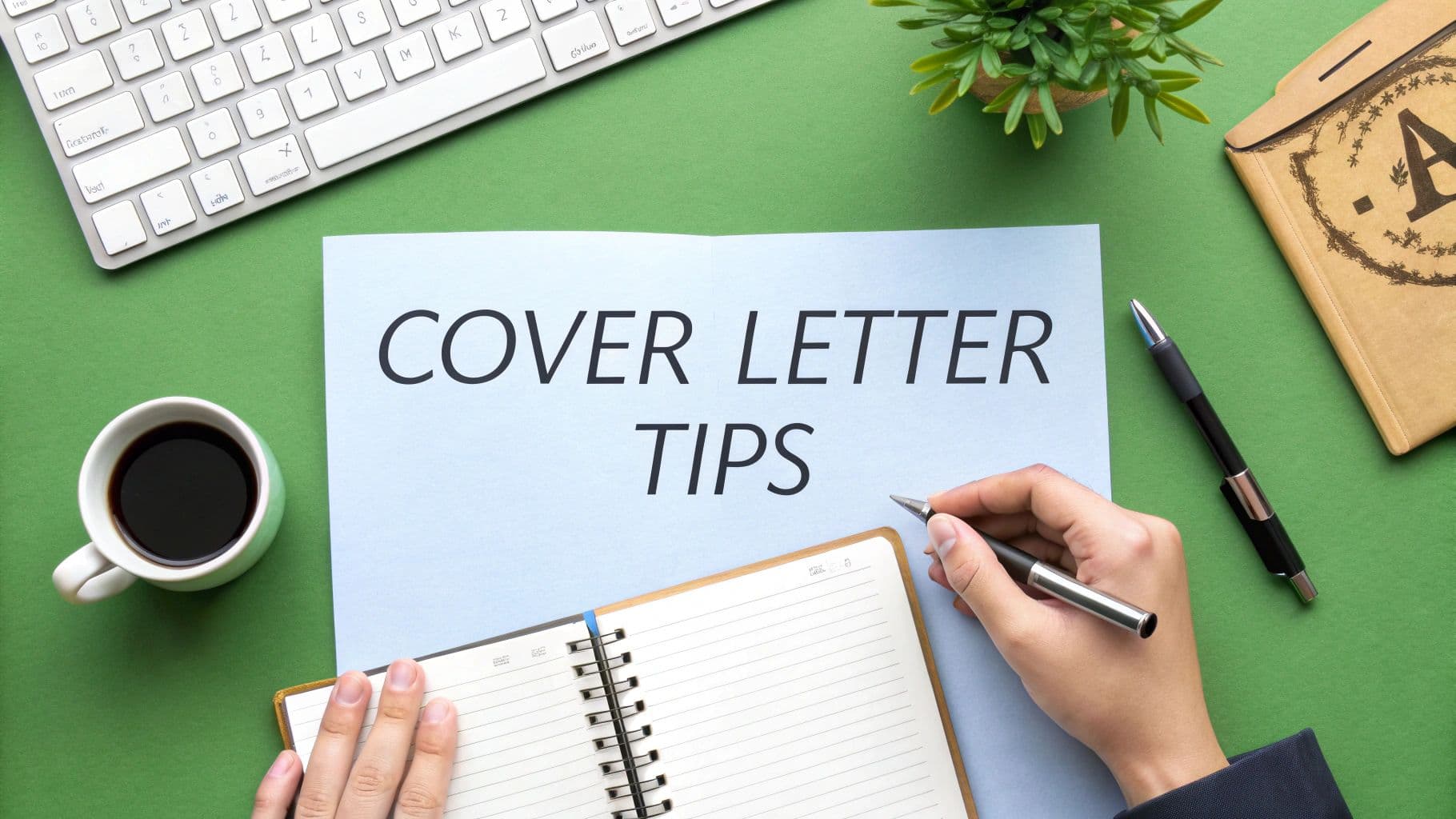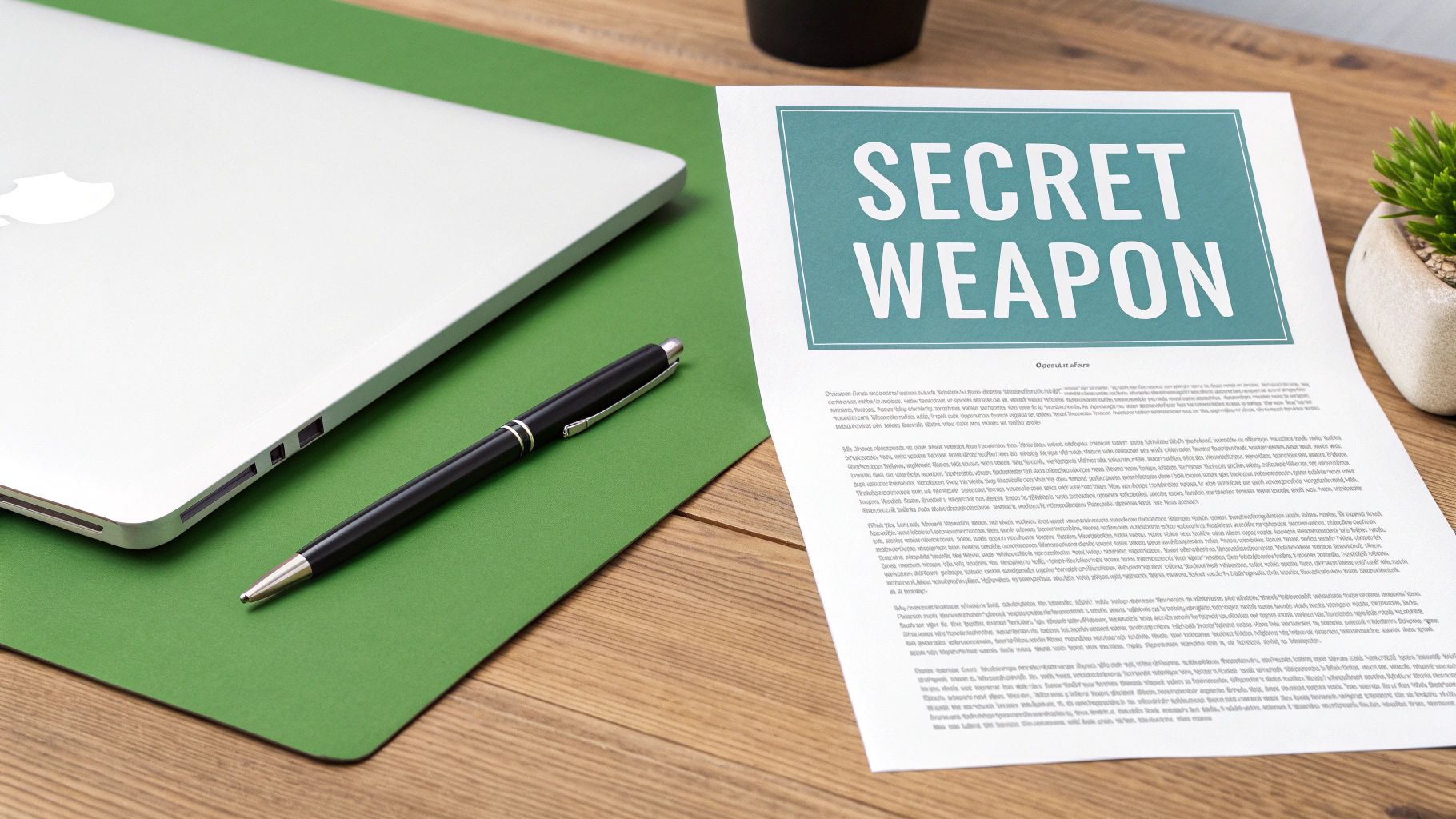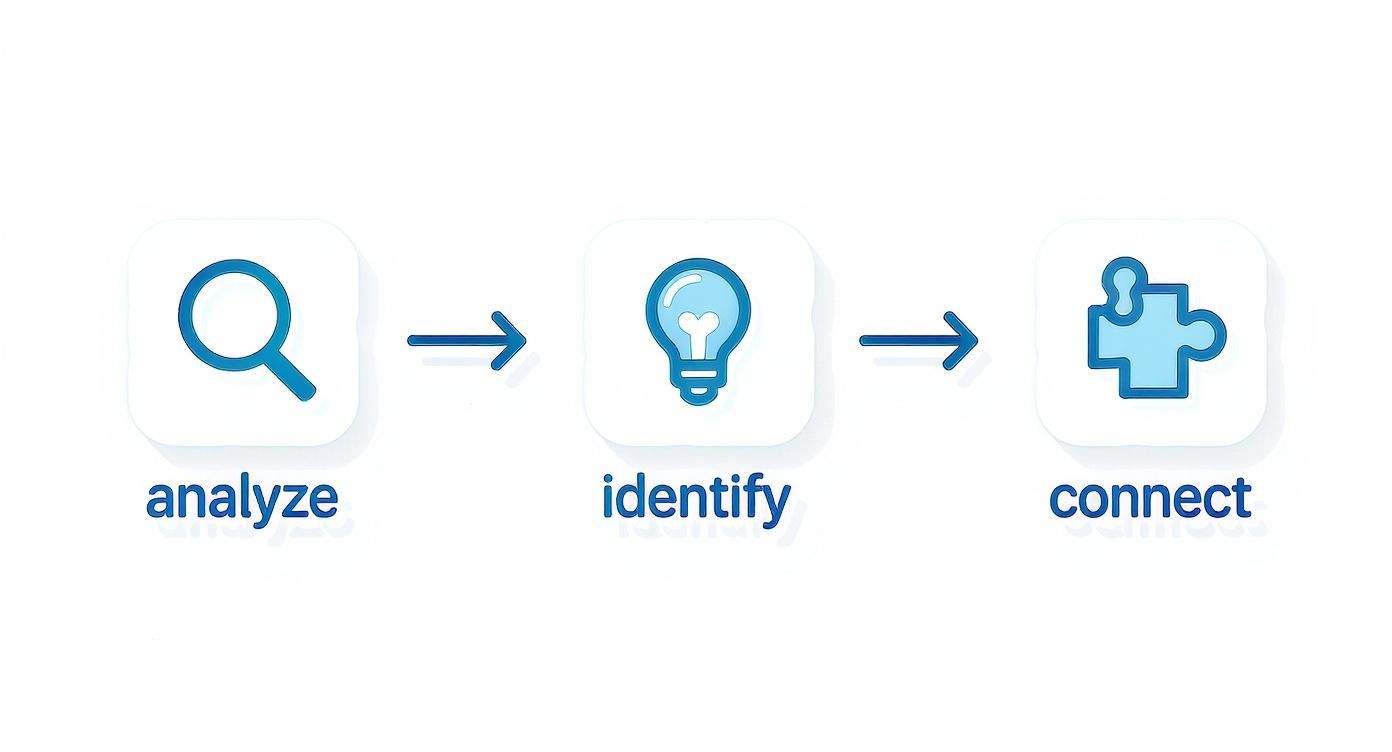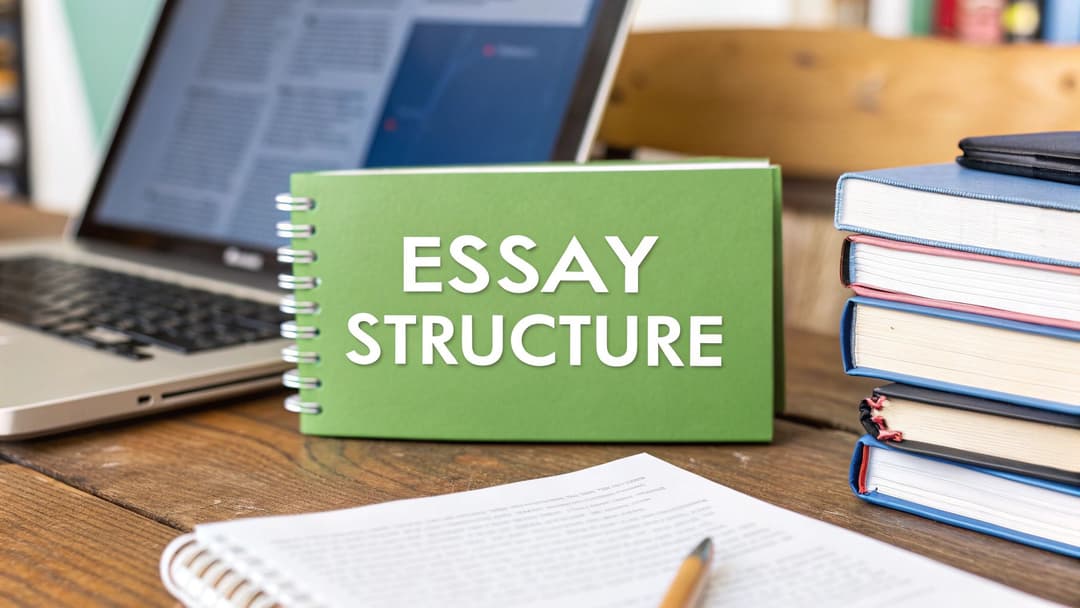
How to Write a Cover Letter That Gets Noticed
November 15, 2025
Your cover letter is so much more than a formality. It’s where you stop being a list of bullet points and start being a person.
This is your chance to connect the dots for a hiring manager, showing them not just what you’ve done, but why it makes you the perfect person to solve their problems. It’s about turning your application from a flat document into a compelling pitch.
Why a Great Cover Letter Is Your Secret Weapon

Let's be honest: most people see the cover letter as a chore. They rush through it, send something generic, and hope for the best. That's a huge mistake. In a sea of applicants, a thoughtful cover letter is your single biggest advantage. It's the one place where you can inject personality, add context, and make a persuasive argument that a resume just can't.
Think of it this way: your resume lists your accomplishments. Your cover letter explains why those accomplishments matter to this specific company.
Instead of just saying you "managed social media," you can tell a short story about how you grew an online community and what that taught you about the very audience they’re trying to reach. That’s the kind of connection that gets you an interview.
The Modern Hiring Landscape
The cover letter isn't dead—far from it. Recent data shows that 83% of hiring managers read cover letters even when they're optional.
And for nearly half of them—a full 45%—it’s the very first thing they look at. It frames their entire impression of you before they even glance at your resume.
What's more, a staggering 72% of recruiters expect a personalized letter. They can spot a copy-paste job from a mile away, and they almost always dismiss it.
So, what does this mean for you? It means your cover letter has to do some heavy lifting. It needs to:
- Grab their attention immediately. Your first sentence can't be, "I am writing to apply for..." It has to be a hook.
- Show you've done your homework. You need to prove you understand the company, its mission, and its challenges. Generic flattery is a waste of everyone's time.
- Connect your skills to their problems. The entire letter should be a direct answer to the needs you see in the job description, positioning your experience as the solution.
Before we dive into the step-by-step process, let's look at the core elements that make a cover letter truly work. This table breaks down the key components and why they are so critical to your success.
Key Components of a Winning Cover Letter
| Component | Purpose | Why It Works |
|---|---|---|
| Compelling Hook | To grab the reader's attention from the very first sentence. | It makes your letter stand out from the pile and encourages the hiring manager to keep reading. |
| Clear Connection to Role | To show you understand the job and what the company is looking for. | It demonstrates genuine interest and proves you're not just mass-applying to every open position. |
| Personalized Story | To illustrate your skills with a brief, relevant example or narrative. | Stories are memorable and create an emotional connection that a list of skills can't. |
| Quantified Achievements | To provide concrete proof of your impact using numbers and data. | It turns vague claims into hard evidence of your value, showing what you can deliver. |
| Confident Close | To end with a clear, proactive call to action. | It shows initiative and makes it easy for the recruiter to take the next step: scheduling an interview. |
Each of these pieces plays a vital role in building a narrative that is both professional and persuasive. Mastering them is the key to turning your application from just another resume into an invitation to a conversation.
Your cover letter is not a summary of your resume; it's a bridge between your past accomplishments and the company's future needs. Think of it as the trailer for the movie that is your career—it should make them excited to see the full feature.
Your Personal Marketing Document
At the end of the day, a cover letter is a marketing document, and the product is you. It needs a clear, confident voice and has to meet certain professional expectations. Getting the basics of https://naturalwrite.com/blog/professional-writing-standards right is non-negotiable if you want your message to land with authority.
For more great advice on crafting job applications that get results, check out Jobsolv's comprehensive blog category on resumes and cover letters. It’s packed with insights that can help you sharpen every part of your job search.
How to Decode the Job Description
Before you even think about writing your cover letter, you need to put on your detective hat. The job description is your main piece of evidence, and trust me, it’s full of clues.
Most people just scan it for keywords. Don't do that. Your job is to read between the lines and figure out what the company's real problem is.
Think of it this way: a job description isn't just a to-do list; it's a cry for help. They have a problem, and they’re looking for someone—anyone—to come in and solve it. Your entire mission is to become that person.
Look for phrases that hint at a challenge, like "oversee a major transition," "build from the ground up," or "streamline our current process." Words like these are gold. They point directly to where the company is feeling the most pressure, and that's exactly where you can position yourself as the perfect solution.
Identify the Core Problem
Start by highlighting the main responsibilities and qualifications. Then, take a step back and ask yourself: What's the bigger picture here? What larger goal are all these tasks trying to achieve?
Are they trying to grow revenue? Fix a broken customer service process? Launch a new product before a competitor does?
For example, if a marketing role asks for experience with "SEO, content creation, and analytics," they aren't just looking for a generalist. It’s highly likely they're struggling with getting traffic to their website or are failing to generate good leads. You need to frame your skills as the direct answer to that specific, underlying problem.
The best cover letters don't just list skills. They connect those skills to a problem. They say, "I see what you're struggling with, and here's how I've fixed that exact same issue before."
Look for Cultural Cues
Beyond the technical stuff, pay close attention to the language they use. Does the company sound buttoned-up and corporate, or more laid-back and collaborative?
Words like "fast-paced," "innovative," "team-player," and "detail-oriented" aren't just buzzwords to ignore. They’re clues about the work environment and the kind of person who will actually fit in.
- "Fast-paced environment" is often code for: we need someone who can handle chaos and won't need their hand held.
- "Collaborative spirit" usually means they value people who can communicate and work well in a team, not lone wolves.
- "Strong attention to detail" could be a sign that their last hire made some expensive mistakes, and now they’re looking for someone they can rely on.
When you dissect a job description this way, you move past just matching keywords. You start gathering real intelligence. This is what allows you to write a cover letter that speaks directly to their needs, making your application feel less like a random resume drop and more like a thoughtful, targeted solution.
Honestly, this first step is non-negotiable if you want to write a letter that actually gets read.
Building Your Cover Letter Section by Section
Okay, you've torn apart the job description and have all the raw materials you need. Now it’s time to actually build the cover letter.
The best way to think about it isn't as some stuffy, formal document. It’s a strategic conversation with three distinct parts: the hook, the argument, and the call to action. Each one has a job to do, moving the hiring manager from "who's this?" to "we need to talk to them."
This whole process is about translating what you know they need into a story about what you can do. The infographic below really nails how to turn those insights from the job description into the core of your letter.

See the connection? Your cover letter isn't just a list of your skills. It’s about drawing a direct line from your experience to their problems.
Crafting a Compelling Opening Hook
That first paragraph is your one shot. Don't waste it.
Forget the painfully generic, "I am writing to apply for..." line that everyone uses. You need to start with something confident and engaging that immediately connects you to the company or the role itself.
Here are a few ways to do that:
- Show you're paying attention. Mention a specific company project, a recent article you read about them, or a core value that genuinely clicks with you. For instance: "When I saw the launch of Project Nightingale, I was immediately drawn to your company's innovative approach to patient data management."
- Lead with a big win. Hit them with a powerful accomplishment that’s directly related to the job's main goal. Something like this for a sales role: "In my last role, I grew my territory's revenue by 42% in just over a year by rolling out a new client outreach strategy, and I see a similar opportunity for growth at your company."
- Use a personal connection. If someone referred you or if you're a long-time user of their products, say so. "A former colleague of mine, Jane Doe, insisted I reach out about the Senior UX Designer position, knowing my passion for creating intuitive mobile experiences."
This opening sets the whole tone. It proves you've done your homework and aren't just spamming out another application. It gives them a reason to actually care and keep reading.
Building the Body with a Problem-Solution Framework
The middle of your letter is where you make your case. But don't just list your old job duties. That’s what your resume is for.
Instead, frame your experience as a series of problems you've solved. This directly addresses the pain points you pulled from the job description earlier.
For each key requirement you identified, tell a quick story in a short paragraph. It’s a simple but effective formula:
- The Problem: Briefly state a challenge you faced that mirrors what they’re likely dealing with.
- Your Action: Describe the specific things you did to tackle it.
- The Result: Quantify the outcome. Use numbers whenever you can.
This isn't just a hunch; a deep dive into over 80 studies confirms this is the best format for most roles, especially in sales, marketing, and management. And for more technical jobs, an Achievement-Focused approach that highlights measurable impact is king. What's wild is that the same analysis found that 89% of hiring professionals still expect a cover letter.
Here's an example for a Marketing Role:
"At my last company, we were really struggling with low organic traffic. I spearheaded a new content strategy focused on long-tail keywords relevant to our niche, which kicked off with a full audit of our existing blog. In six months, we boosted organic search traffic by 150% and doubled our lead conversions from that content alone."
See how much better that is? It’s far more persuasive than just saying you have "experience in SEO." It proves your value.
Closing with a Confident Call to Action
Your final paragraph needs to be confident, professional, and proactive. Remind them of your enthusiasm for the role and make it clear you want to talk about how you can help them.
Ditch passive, hopeful phrases like "I look forward to hearing from you." You're better than that. Instead, you propose the next step.
A strong close sounds something like this: "I am eager to discuss how my experience in streamlining supply chains can directly contribute to your team's efficiency goals. I'm available for a conversation next week."
That confident finish leaves a great impression and makes it dead simple for the hiring manager to take the next step. And if you're staring at a blank page, you might consider using an AI Cover Letter Generator to get a solid first draft to work from.
Finding Your Authentic Tone and Voice
A generic cover letter is the fastest way to get your application tossed. To stand out, you need to write in a way that sounds like you, but also fits the company’s culture. This means your tone—the personality and attitude in your words—is just as important as the facts on your resume.
Think about it. You wouldn't apply for a job at a playful startup using the same stiff language you’d use for a centuries-old law firm. It just wouldn't land. The first move is to do a little recon. Check out the company’s "About Us" page, read their blog posts, and scroll through their social media. You'll get a feel for their voice pretty quickly.
Matching Your Tone to the Company Culture
Once you have a sense of their vibe, you can adjust your own writing style. Are they buttoned-up and serious, or do they use emojis and a chatty, informal style? Mirroring their approach shows you've done your homework and actually get what they're about.
- For Corporate Roles: It’s usually best to lean toward a formal, professional tone. Stick to clear, direct language and skip the slang or overly casual phrases. The goal here is to project competence and respect for their established way of doing things.
- For Startup or Creative Roles: You often have more freedom to let your personality show. A creative opening, a bit of humor, or a more passionate tone can work wonders. It signals that you'll fit right into a dynamic, less rigid environment.
Getting your tone right is a huge part of professional communication. If you want to go deeper on this, our guide on what is tone in writing has more detailed examples and strategies.
Your authentic voice isn't about being unprofessional. It's about finding the sweet spot where your personality and the company's culture overlap. Write like yourself—but like the version of yourself who already works there.
The Power of Personalization
Beyond getting the tone right, personalization is your secret weapon. Always, always try to find the hiring manager's name. A quick LinkedIn search for the department head or a recruiter at the company usually does the trick. Addressing your letter to a specific person ("Dear Ms. Chen") is so much more powerful than the lifeless "To Whom It May Concern."
This small detail matters more than you might think. A survey of 625 hiring managers revealed that 83% read most cover letters even when they aren't required, and a whopping 94% said the letter influences their interview decisions. In the tech world, startups are particularly keen on them, with 65% making them mandatory. Taking a few extra minutes to personalize your letter gives you a massive edge.
The Final Polish Before You Hit Send

You’ve spent hours dissecting the job description, weaving your story, and finding just the right words. Now comes the last, crucial step. Don’t let all that effort go to waste because of a simple, avoidable mistake right at the finish line. This is your quality control check.
Even the most powerful message gets torpedoed by a glaring typo or a weird formatting glitch. Hiring managers are always looking for easy ways to thin the herd of applicants, and a sloppy letter is a massive red flag. It instantly suggests a lack of attention to detail—a skill that’s valuable in almost any job.
So, think of this final review not as a chore, but as the last push that makes sure your hard work actually pays off. This is where a good draft becomes a great one.
Proofreading Like a Pro
After staring at the same page for hours, your eyes start to play tricks on you. You see what you think you wrote, not what’s really there. To actually catch those sneaky errors, you need to trick your brain into seeing the text differently.
Here’s one of the most effective techniques I know: read your entire cover letter out loud. It feels a little weird, but it forces your brain to slow down and process every single word. You will be shocked at how many awkward phrases, clunky sentences, and typos jump out when you hear them.
Another game-changer is getting a second set of eyes on it.
Ask a friend you trust, a family member, or a mentor to give it a quick scan. A fresh perspective is priceless for catching mistakes you’ve gone blind to. They can also tell you if your tone is hitting the right note.
The Human Element in an AI World
AI grammar checkers are fantastic for a first pass. They'll catch common spelling errors, punctuation mistakes, and basic slip-ups in a heartbeat. Running your draft through one is a smart move to clean up the easy stuff.
But they have their limits. These tools don’t always get the context or the nuance of your voice. An AI might flag a sentence as too complex when it’s actually a stylistic choice that adds personality.
Ultimately, nothing beats a human review—starting with your own. For a more structured approach, a detailed guide like this self-editing checklist can help you methodically cover all your bases.
Before you send that email, it's worth taking one last look with a clear checklist in mind. This small step ensures everything is in its right place.
Final Review Checklist
| Check | Action Item | Why It's Critical |
|---|---|---|
| Contact Info | Double-check your name, email, and phone number. | A single typo here means they can't contact you, even if they love your letter. |
| Recipient Info | Verify the hiring manager's name and title. | Getting their name right shows you've done your homework. |
| Read Aloud | Read the entire letter out loud, slowly. | Your ears will catch awkward phrasing and typos your eyes miss. |
| Grammar & Spelling | Run a final check with a tool, then manually review. | Small mistakes can signal a lack of professionalism or attention to detail. |
| Formatting | Ensure consistent font, spacing, and margins. | A clean, professional look makes the letter easy to read and shows care. |
| Tone & Voice | Does it sound like you? Confident but not arrogant? | The tone should match both your personality and the company's culture. |
Your goal is to submit a letter that’s not just compelling but completely polished. This final check shows you respect the reader's time and helps you make a fantastic first impression.
Common Cover Letter Questions Answered
Even when you have a great plan, writing a cover letter can throw a few curveballs your way. It’s easy to get stuck when you’re dealing with a career gap or applying for a job that feels like a bit of a reach.
This is your guide for those tricky "what if" moments. We're going to tackle the questions job seekers ask most often, with clear, practical advice to get you unstuck.
Think of it as your troubleshooting guide. Let's clear up any doubts so you can handle any application with a steady hand.
How Do I Address a Career Gap?
First things first: don't hide it. An unexplained gap is a huge red flag, and you can bet a hiring manager will notice. The trick is to address it briefly and confidently, framing it as a constructive period in your life.
You don’t need to share a long, personal saga. Often, a single, straightforward sentence is all it takes to bridge the gap before you pivot right back to your qualifications.
Example for a Career Gap:
"After taking a year to care for a family member, I'm now eager to bring my renewed focus and dedication to a challenging project management role. That time reinforced my skills in prioritization and resilience, which I'm excited to apply to your team's goals."
This approach is honest and professional, and it turns a potential negative into something positive. It shows maturity and reframes the time away as an experience that actually added to your skillset.
What If I Don’t Meet All the Requirements?
Relax. It's incredibly rare for any candidate to be a 100% match for every single bullet point on a job description. A lot of job descriptions are more of a "wish list" than a rigid checklist.
Don’t let a few missing qualifications stop you from applying. Your cover letter is the perfect place to handle this head-on. Focus on what you do bring to the table and show you're genuinely excited to learn the rest.
- Highlight Your Transferable Skills: Show how experience in one area applies to another. Maybe your customer service background gave you killer communication skills that are perfect for a sales role.
- Show You're Eager to Learn: Mention you're a quick study and are genuinely excited by the chance to grow. A positive, can-do mindset is a massive asset.
- Focus on Your Strengths: Draw their attention back to the requirements you absolutely nail, especially if they’re the most critical ones for the job.
Your goal isn't to apologize for what you lack. It's to shift the conversation to the immense value you offer.
Should I Send a Cover Letter If It’s Optional?
Yes. Always yes. When a cover letter is listed as "optional," see it for what it is: a golden opportunity. Most applicants will take the easy way out and skip it.
That means your thoughtful letter will immediately make you stand out.
Think of it as the ultimate tiebreaker. If you and another candidate have nearly identical resumes, a compelling cover letter that reveals your personality and real interest can easily tip the scales in your favor. It shows you’re willing to go the extra mile—and that's a quality every single employer is looking for.
Feeling confident about your next application? Turn that confidence into a polished, professional document. Natural Write can help you refine your AI-generated drafts, ensuring your unique voice shines through while passing any AI detection. Humanize your cover letter with one click at https://naturalwrite.com.


